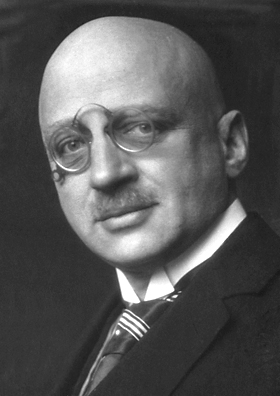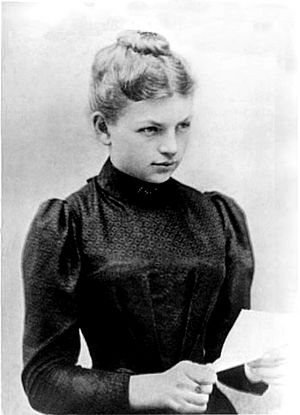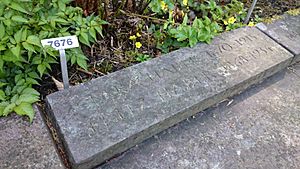Fritz Haber facts for kids
Quick facts for kids
Fritz Haber
|
|
|---|---|

Fritz Haber, c. 1919
|
|
| Born | 9 December 1868 Breslau, Province of Silesia, Kingdom of Prussia
|
| Died | 29 January 1934 (aged 65) Basel, Switzerland
|
| Nationality | German |
| Alma mater | |
| Known for |
|
| Spouse(s) | |
| Children | 3 |
| Awards |
|
| Scientific career | |
| Fields | Physical chemistry |
| Institutions |
|
| Doctoral advisor | Carl Theodore Liebermann |
Fritz Haber (9 December 1868 – 29 January 1934) was a German chemist. He won the Nobel Prize in Chemistry in 1918. This award was for his invention of the Haber–Bosch process. This method makes ammonia from nitrogen and hydrogen gases.
This invention is very important for making fertilisers and explosives. It is thought that one-third of the world's food production uses ammonia from this process. This helps feed nearly half of the world's people. Haber also helped create the Born–Haber cycle with Max Born. This cycle helps understand the energy in ionic solids.
Haber was a strong German nationalist. He is also known as the "father of chemical warfare". He worked on developing and using chlorine and other poisonous gases. This happened during World War I. He first suggested using heavy chlorine gas as a weapon. This was to break the stalemate in the trenches. His work later helped develop Zyklon A, which was used as an insecticide.
After the Nazis came to power in 1933, Haber had to leave his jobs. This was because he was Jewish. He was already not well. He traveled to different countries. Chaim Weizmann then asked him to lead the Sieff Research Institute. This institute is now the Weizmann Institute in Rehovot, Mandatory Palestine. Haber accepted the offer. But he died from heart failure on his journey. He passed away in a Basel hotel on 29 January 1934, at age 65.
Many people consider Haber one of the most important scientists ever. He might be the greatest industrial chemist in history.
Contents
Early Life and Education
Haber was born in Breslau, Kingdom of Prussia. This city is now Wrocław, Poland. He came from a wealthy Jewish family. His family had been in business, politics, and law for a long time.
Fritz was the son of Siegfried and Paula Haber. His mother, Paula, died shortly after he was born. This left his father, Siegfried, very sad. Fritz was cared for by his aunts. When Fritz was about six, his father remarried Hedwig Hamburger. Fritz had a difficult relationship with his father. But he was close to his stepmother and his three half-sisters.
Haber's family had become part of German society. He went to schools open to all religions. He identified strongly as German, less so as Jewish.
Haber finished high school in 1886. His father wanted him to work in the family dye business. But Haber got permission to study chemistry instead. He studied at the Friedrich Wilhelm University in Berlin. He also studied at Heidelberg University and the Technical College of Charlottenburg.
In 1889, Haber joined the military for a year. After that, he returned to his studies. He worked under Carl Liebermann. Haber earned his doctorate in 1891.
After getting his degree, Haber worked at his father's business. But they often disagreed. Haber then took apprenticeships at different chemical companies. These experiences made him want to learn more about industrial processes. He also studied at the Swiss Federal Institute of Technology in Zürich. Eventually, his father agreed that they could not work together.
Starting His Career in Chemistry
Haber then looked for a job in academics. He worked as an assistant at the University of Jena. During this time, he changed his religion from Judaism to Lutheranism. This might have been to help his career.
In 1894, he joined the University of Karlsruhe. He became an assistant to Hans Bunte. Bunte suggested Haber study how hydrocarbons break down with heat. Haber's careful work showed that carbon-carbon bonds are stronger in some compounds. This research became his main thesis for teaching.
Haber became a private lecturer at Karlsruhe. He taught about dye technology. He also continued to study how gases burn. He traveled to learn about new developments in dye technology and electrochemistry.
In 1898, Haber published a book on electrochemistry. This book gained a lot of attention. He worked with other scientists in this field. In December 1898, he became an associate professor.
Haber worked on many different topics at Karlsruhe. He made important contributions to dye and textile chemistry. He also explained autoxidation in electrochemical terms. His work on the thermodynamics of reactions was also very important. In 1905, he published another key book on gas reactions.
In 1906, Haber became a full professor of physical chemistry at Karlsruhe.
The Nobel Prize Discovery
While at the University of Karlsruhe, Haber and his assistant Robert Le Rossignol made a huge discovery. They invented the Haber–Bosch process. This process uses a catalytic method to create ammonia. It uses hydrogen and nitrogen from the air. This happens under high temperature and pressure.
This discovery was based on Le Châtelier's principle. This principle says that a system will try to lessen any changes made to it. Scientists knew how to break down ammonia. So, they figured out how to reverse the reaction to make ammonia.
To make ammonia on a large scale, Haber worked with industry. He partnered with Carl Bosch at BASF. They successfully made the process work for commercial production. The Haber–Bosch process changed industrial chemistry.
Before this, making nitrogen-based products like fertiliser depended on limited natural sources. Now, it was possible using nitrogen from the air. This led to much larger amounts of nitrogen-based fertilizers. This, in turn, helped grow much more food. It now supports half of the world's population.
The Haber process also had a big economic impact. Chile used to be a main exporter of natural sodium nitrate. After the Haber process, the demand for natural nitrate dropped a lot.
Today, the world produces over 100 million tons of synthetic nitrogen fertiliser each year. The food for half the world's people relies on the Haber–Bosch process.
Haber received the 1918 Nobel Prize in Chemistry for this work. He actually got the award in 1919. In his speech, he said that nature's ways of using nitrogen are still more advanced than what humans can do.
Haber also researched combustion reactions. He looked into separating gold from seawater. He also studied adsorption and electrochemistry. Much of his later work was done at the Kaiser Wilhelm Institute for Physical Chemistry and Electrochemistry in Berlin-Dahlem. This institute was renamed after him in 1953.
World War I Involvement
Haber was very excited about World War I. He was one of many German thinkers who signed a statement supporting the war. He played a big part in developing chemical warfare during the war. This was despite international agreements against using such weapons.
He was promoted to captain and led the Chemistry Section in the Ministry of War. Haber led teams that developed chlorine gas and other deadly gases. These were used in trench warfare. He was present when the German military first used gas at the Second Battle of Ypres in Belgium. His team included over 150 scientists.
Haber also helped create gas masks. These masks had filters to protect against the gases. A special troop was formed for gas warfare. Future Nobel Prize winners like James Franck and Otto Hahn served in Haber's unit.
Haber believed that during wartime, a scientist belongs to their country. He was a proud German patriot. He was even given the rank of captain by the Kaiser.
Haber studied how poison gas affected people. He noticed that a small amount of gas over a long time could be as deadly as a large amount for a short time. He created a mathematical rule for this. It is now known as Haber's rule.
Haber defended gas warfare. He said that death was death, no matter how it happened. He argued that gas weapons were not more cruel than other weapons. However, he received a lot of criticism for his role in chemical weapons. This criticism came from people like Albert Einstein and other scientists.
Between the World Wars
After World War I, from 1919 to 1923, Haber continued to be involved in Germany's secret chemical weapons development. He worked with Hugo Stoltzenberg. He also helped Spain and Russia develop chemical gases.
In the 1920s, scientists at Haber's institute developed cyanide gas. This was called Zyklon A. It was used as an insecticide, especially for fumigating grain stores.
Haber also spent years trying to extract gold from seawater. He published many papers on this. But he found that there was much less gold in seawater than thought. So, it was not profitable to extract it.
By 1931, Haber was worried about the rise of National Socialism in Germany. He was concerned for his Jewish friends and family. In 1933, new laws targeted Jewish scientists. Haber was ordered to fire all Jewish staff. He tried to delay this to help them find new jobs.
On April 30, 1933, Haber resigned from his positions. He was the director of the Kaiser Wilhelm Institute and a university professor. He said that even though he might legally stay, he did not want to. He had converted to Christianity and served Germany in World War I. He thought this would make him a patriot.
Haber and his son Hermann urged his children to leave Germany. His second wife, Charlotte, and their children moved to the United Kingdom.
Personal Life and Family

Haber met Clara Immerwahr in 1889. She was the first woman to earn a PhD in chemistry at the University of Breslau. She converted to Christianity before marrying Haber on August 3, 1901. Their son, Hermann, was born in 1902.
Clara was a supporter of women's rights. She became very sad after her marriage and losing her career. On May 2, 1915, Clara died in their garden after an argument with Haber. She was first buried in Dahlem. Later, her remains were moved to Basel to be buried next to Haber.
Haber married his second wife, Charlotte Nathan, in 1917. She also converted to Christianity before their marriage. They had two children, Eva-Charlotte and Ludwig Fritz. However, they divorced in 1927.
Haber and Clara's son, Hermann, lived in France. He later moved to the United States with his family during World War II. Haber's other son, Ludwig Fritz Haber, became a British economist. He wrote a book about chemical warfare in World War I. His daughter Eva lived in Kenya before returning to England.
Later Years and Death
Haber left Germany in August 1933. He stayed in Paris, Spain, and Switzerland. He was very ill during these travels. He suffered from angina, which are chest pains from heart problems.
Some British scientists who had been his rivals during World War I helped him. They invited him to Cambridge, England. He lived and worked there for a few months. However, some scientists, like Ernest Rutherford, were not forgiving of his role in poison gas.
In 1933, Chaim Weizmann offered Haber a job in Rehovot, Mandatory Palestine. Haber accepted the offer. He left for the Middle East in January 1934. But his health failed him. On January 29, 1934, he died of heart failure in a Basel hotel. He was 65 years old.
Following his wishes, Haber was cremated. His son Hermann arranged for him to be buried in Basel. Clara's remains were later moved to be buried next to him. Albert Einstein, a long-time friend, said Haber's life was "the tragedy of the German Jew – the tragedy of the unrequited love."
Legacy and Recognition
Haber left his large personal library to the Sieff Institute. It was named the Fritz Haber Library in 1936. It is still a private collection there.
In 1981, a research center was established in his name. It is the Fritz Haber Research Center for Molecular Dynamics. It promotes scientific teamwork between Israel and Germany.
The institute where he did much of his work was renamed the Fritz Haber Institute in 1953. It is part of the Max Planck Society.
Awards and Honors
- Foreign Honorary Member, American Academy of Arts and Sciences (1914)
- Nobel Prize in Chemistry (1918)
- Bunsen Medal of the Bunsen Society of Berlin, with Carl Bosch (1918)
- President of the German Chemical Society (1923)
- Wilhelm Exner Medal, 1929
- Honorary Member, Société Chimique de France (1931)
- Honorary Member, Chemical Society of England (1931)
- Honorary Member, Society of Chemical Industry, London, (1931)
- Rumford Medal, American Academy of Arts and Sciences (1932)
- Elected a Foreign Associate of the National Academy of Sciences, USA (1932)
- Honorary Member, USSR Academy of Sciences (1932)
- Board of Directors, International Union of Pure and Applied Chemistry, 1929–1933; Vice-President, 1931
- Goethe-Medaille für Kunst und Wissenschaft (Goethe Medal for Art and Science) from the President of Germany
Stories and Films About Haber
Fritz Haber's life has been shown in plays and films.
A play called Einstein's Gift (2003) tells a fictional story of Haber's life. It shows his struggles with his Jewish background and the moral questions of his science.
BBC Radio 4 has broadcast two plays about Haber. One was called The Greater Good (2008). It explored his work on chemical warfare in World War I. It also showed the stress it put on his wife, Clara.
In 2008, a short film titled Haber showed his decision to work on gas warfare. It also showed his relationship with his wife.
In 2012, Radiolab had a segment about Haber. It covered the Haber Process, the Second Battle of Ypres, and his work with Zyklon A.
In 2013, a BBC World Service radio program asked: "Why has one of the world's most important scientists been forgotten?".
His life and his relationship with the Einsteins are in the novel A Reunion of Ghosts.
The TV series Genius (2017) also showed Haber's life and his connection to Albert Einstein.
In 2022, the band Sabaton released a song called "Father." It talks about Haber's mixed legacy. This includes his role in chemical warfare and the importance of the Haber-Bosch process for food.
See also
 In Spanish: Fritz Haber para niños
In Spanish: Fritz Haber para niños
- Nobel laureates in Chemistry
- List of Jewish Nobel laureates
- Luggin–Haber capillary


